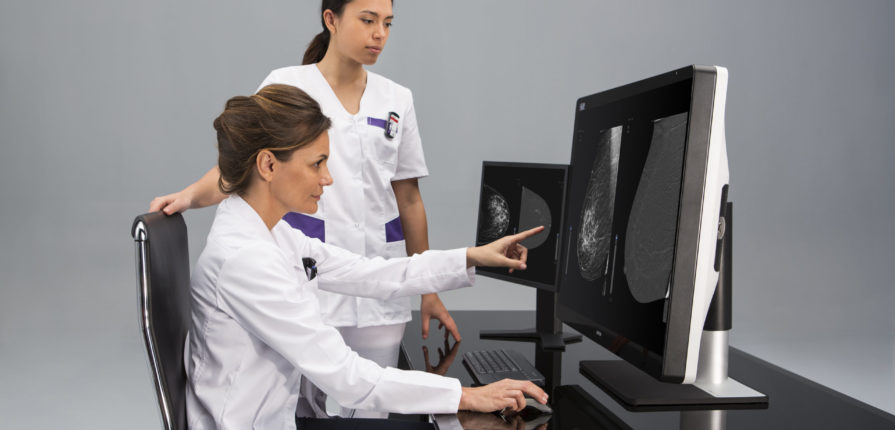With COVID-19 receding in many parts of the globe, what does a new normal for mammography look like? Clinics in the United States are building this future – cautiously, at different speeds, and with safety in mind – but also with a sense of urgency as more than 94% of mammograms were delayed during the pandemic.[1] Providers have a common goal: get back to catching cancer sooner by boosting screening capacity, adapting workflows, and enhancing the patient experience.
To better understand how clinicians are working to keep mammograms safe in this new normal, the MyMammo team spoke with several breast care experts and would like to share their thoughts.
Patient communication is key, and with new guidelines being put in place, practices have had to redefine how they communicate with patients from the moment they schedule their appointment to discussing their results. In fact, communication is a vital determinant of patient comfort and education in our current medical environment.
“I think one of the most important things that we found to make people comfortable is really a lot of communication.” Dr Gary Dee, President of Midstate Radiology says, “Before they come in, when they come in and after they’re done – making sure they understand what they’re going through and that we will try to make them safe. It’s all about communicating with the patient. And once you communicate with them, explain to them what you’re going to be doing, they’re much more comfortable. This has all worked very successfully, as we’ve already seen our volumes go from almost nothing to 70% already.”
There are other ways to increase communication and one way is to leverage social media. Something that Dr. Patton, an OB-GYN has done at his practice. “One of the smartest things I’ve done is hire a social media specialist. We’ve made an effort to use multiple media platforms to engage our patients on how we’re handling the COVID-19 situation. We’re trying to instill in them that we’re using the best practices to try and ensure their safety, as well as the staff safety. Then our staff does a phone call as a courtesy as well, just to make sure there are no other questions or concerns regarding the patient’s exam or regarding their mammogram.”
During COVID-19 the patient experience changed, but it’s changed for the better. To encourage patients to come in for their breast cancer screenings, many clinics have implemented protocols to protect both patients and staff and improve the patient experience despite challenging conditions.
Doctors are doing this in different ways. For Dr. Patton this involved changing the way he sees patients and what exams they can perform in one day: “Since the beginning of the pandemic, I think that we have had a heightened awareness of patient safety. At my practice, patients can have their gynecological exam, mammogram, and supplemental screenings like ultrasound all done in the same appointment. A lot of patients have transferred to our practice because of this convenience. In today’s environment, it means they don’t have to be exposed to two different places, at this point for COVID or any other infection. It’s been a big hit amongst the patients. I think there are some things that will probably be forever changed. It’s a new standard of care that’s different from what we’ve all experienced.”
Another thing that has truly heightened during this time is sanitation and especially the visibility of it. Dr. Fried’s practice is using this to comfort their patients: “For us, making sure that they see us follow the rules that we’ve laid out for them. Wearing our masks and having things like masks and hand sanitizer available for the patients if they don’t have their own. And then, having the patients watch us clean our hands when we walk into the room. I mean, this is good practice at any time. But, especially now for the patients to know before you touch them. That you’ve cleaned your hands and they aren’t at higher risk because you’re laying your hands on them.”
The pandemic has accelerated digital breast care and the pressure of COVID-19 has fast tracked many software solutions, telemedicine, and AI tools that are now an essential part of treating patients and working through backlogs.
Profound AI is an AI tool that Dr. Fried uses in her practice: “Data and analytics will play a key role here and it also helps with when the case is done. For those patients returning, a workflow tool such as Profound AI may help with reading cases. Profound AI is a concurrent-read, cancer detection and workflow solution that rapidly analyzes each tomosynthesis image accurately, detecting both malignant soft tissue densities and calcifications and provides a Certainty of Finding and Case Scores. The Certainty of Finding and Case Scores serve as a guide to the interpreting radiologist to aid in determining if a suspicious finding or case needs further workup. “
Digital breast care has combined with COVID-19 best practices to help them run smoothly. Dr Dee’s practice uses digital breast care in a variety of ways: “We developed a virtual waiting room via text messaging software, which has been extremely successful. Patient will stay in their car, and then they’re texted when to come up and have their procedure. We’re also rolling out new telemedicine capabilities. We went from basically very little telemedicine to expanding telemedicine throughout our Medical Group. I feel this may be a way to do diagnostic mammograms. Patients could call in and we could project the images to show them and go over the cases. In this case, they don’t have to wait in the waiting room or in the car to see us. I think I think there’s a huge opportunity become closer to our patients, make it easier for them, have less traveling for them, and use the radiologists in a better manner.”
The way that breast health works has changed, and everyone will have to get used to a new normal. Industry and patients must work together to not only share best practices and experiences, but also find ways to implement them moving forward.
The normal is going to cover a wide range of areas of breast health moving forward as Dr. Fried explains: “We must learn to function in this new normal. We must do as much as we can to make sure that our patients and our techs remain safe – even when it’s not first and foremost and everyone’s mind. Technology providers do play an important role here as a everybody is implementing safety measures. Social distancing is important today. If there’s an issue service need, we usually call for a field engineer. If there’s a training need with standard applications, we’d have the application specialist come into the clinic. Now there’s a need for remote support, remote services and remote virtual training that can be more at the fingertips, versus scheduling something and having another person in the room.”
“I think you had two choices in the pandemic: either to panic or plan for the future. We went from overall imaging volumes to below 50 percent, now our outpatient imaging is over 70 percent today.” Dr Dee says, “This is going to change the way we take care of patients going forward. If we can create a better, new normal out of this, I think that’s what we’re trying to achieve. I think we’ve learned we must focus on our patient experience to make them feel comfortable and trust us. And that, we’re going to take to the future.”
Thank you to this incredible group of clinicians for sharing their insights and learnings. And thank you to all the healthcare providers who continue to put patients first even in this challenging circumstance.
To see the full webinar. Click here.
[1] Accessed on May 12, 2020: https://ehrn.org/wp-content/uploads/Preventive-Cancer-Screenings-during-COVID-19-Pandemic.pdf





Leave a Reply